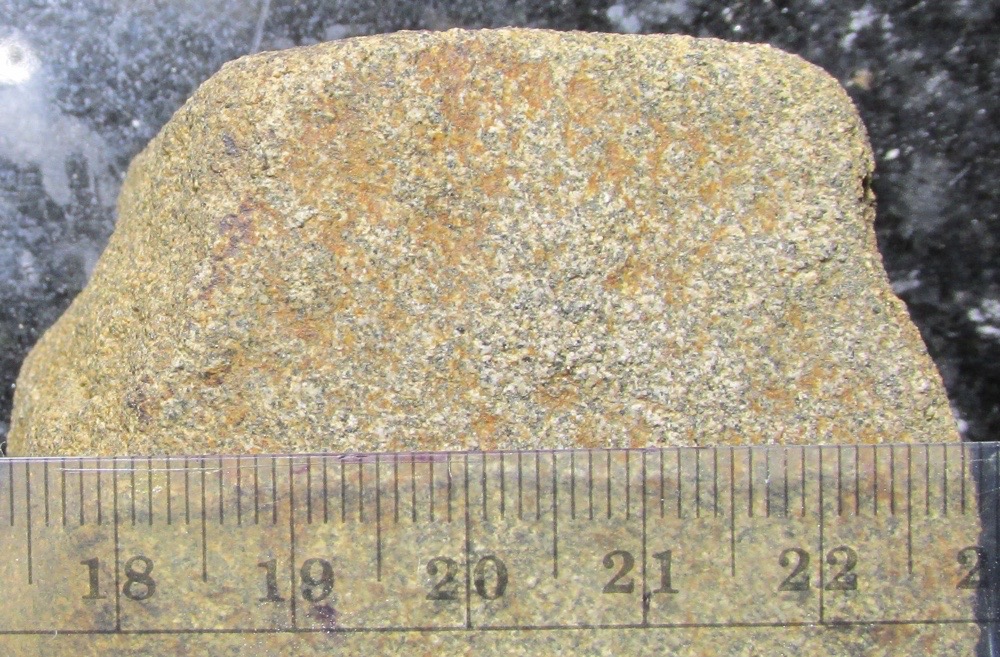I came across some odd rocks on my land a few weeks ago. I puzzled over them for a while and set it aside, hoping that an explanation for their presence would occur to me. That hasn’t happened, so I’m turning the question over to readers.
First, the context: here is the geological map of my area. I have placed a red star on the location where I found the rocks.
The green area marked as “TRPv”, is explained as follows on the supplement:
Volcanic Rocks (Triassic and Permian) — Massive flows of porphyritic meta-andesite, metabasalt, spilt, and keratophyre, volcanic breccia, and subordinate amounts of fine-grained volcaniclastic rocks. In Southwest Oregon includes hornblende, pyroxene, , and plagioclase porphyritic andesite flows, breccia, agglomerate, tuff, and locally, some basalt flows and dacitic tuffs of the Applegate Group.
The areas in lime green marked as Kc are described as follows:
Clastic sedimentary rocks (Upper and Lower Cretaceous) Locally fossiliferous sandstone and conglomerate; marine fossils indicate Early Cretaceous (Albian) age (Jones 1960). Includes the Hornbrook Formation of Peck and others (1956), the Grove Creek strata of Jones (1960) and Page and others (1977), Hunters Cove Formation, Cape Sebastian Sandstone, Humbug Mountain Conglomerate, and Rocky Point Formation (Dott, 1971; Blake and others, 1985) and clastic sedimentary rocks on the West Fork of the Illinois River near Waldo (Imlay and others, 1959), about 12 km south of Cave Junction.
The areas in pink marked as KJg are described as follows:
Granitic Rocks (Cretaceous and Jurassic) Mostly tonality and quartz diorite, but including lesser amounts of other granitoid rocks. Potassium-argon ages determined on hornblende indicates plutons range in age from 143 to 166 Ma (Hotz, 1971)
I have, over many years, scoured my land and confirmed that almost all the rocks on it are metamorphic rocks; they all have a green coloration and appear to conform to the specifications for the TRPv area. I have also found lots of quartz pieces, but I assume that they go along with the TRPv rocks. But I also found an outcrop of granitic rock. I have examined it closely and there’s no question that this is the tip of a pluton (perhaps I should call it a micropluton?)
Now at last I come to the new rocks. They are sandstone, or something very close to it. I found them on a slope about 30 meters below the top of a ridge. Here’s a close photo:

The texture is definitely rough, like sandstone. It’s harder than gypsum, softer than calcite. As you can see from the photograph, it looks like a mix of black and white. However, when I examine scrapings from it, the particles are much smaller than sandstone particles and they are almost uniformly tan. I don’t have a microscope, but the particles appear under a magnifying glass to be smaller than 100 microns.
This is definitely not an alien rock introduced by humans. I found it and others along a small road embankment stretching along a 30 meter section; one was embedded in the soil underneath the roots of an old tree. But the matrix they were in was plain old dirt, so they were probably washed down from a formation that has since disappeared. However, they don’t show a lot of erosion; some have sharp edges and they seem to fracture along non-parallel planes.
I hope I have provided enough information to permit a good explanation. They seem too soft to be part of the Kc sedimentary rocks, which should have had plenty of time to consolidate into hard sandstone. You can respond via the contact form above.
